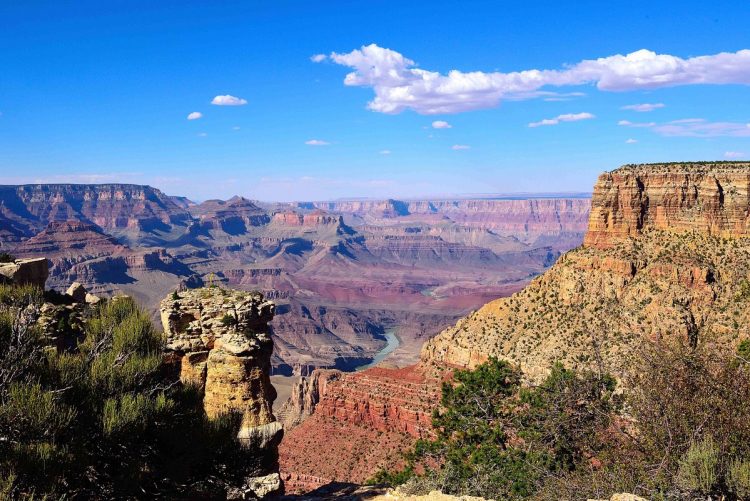Introduction
Grand Canyon National Park, a geological wonder and cultural treasure, is one of the most visited natural attractions in the United States. With its immense size, dramatic cliffs, intricate rock formations, and awe-inspiring vistas, the Grand Canyon offers an unforgettable experience. Over 5 million people visit each year to witness the breathtaking views, explore the diverse ecosystems, and partake in thrilling outdoor activities such as hiking, rafting, and sightseeing.
While the Grand Canyon is a popular destination, it is also a place of immense natural and cultural significance. The park’s geological history, Native American heritage, and wildlife diversity make it a must-see destination for nature lovers, adventure seekers, and history buffs alike. This comprehensive guide will take you through everything you need to know about visiting the Grand Canyon, including essential tips, the best activities, cultural highlights, and much more.
1. What Makes the Grand Canyon National Park So Special?
1.1 The Geological Wonder
The Grand Canyon is more than just a large hole in the ground; it is a geological marvel that provides a unique window into the Earth’s history. Formed over millions of years, the canyon stretches across 277 miles in northern Arizona, varying in width from 4 to 18 miles, and reaching a depth of over a mile (6,093 feet). The rock layers exposed in the canyon walls are some of the oldest and most geologically significant on Earth, making it a haven for geologists and scientists from around the world.
The Grand Canyon was carved primarily by the Colorado River, which still flows through the canyon today. The river, combined with erosion, tectonic activity, and volcanic processes, has created the canyon’s distinctive layered rock formations, including the famous Vishnu Schist and Redwall Limestone. These rocks, representing over 2 billion years of Earth’s history, offer an incredible geological record.
1.2 Rich Cultural Heritage
The Grand Canyon has also been an important cultural site for thousands of years. Native American tribes, including the Havasupai, Hopi, Zuni, and Navajo, have lived in and around the Grand Canyon for centuries. The canyon remains a sacred and spiritual place for these indigenous peoples, who consider it a significant part of their cultural identity.
Beyond the Native American history, the Grand Canyon also has a rich European exploration history. In 1540, the Spanish explorer García López de Cárdenas became the first European to reach the canyon, although it wasn’t until the 19th century that the Grand Canyon gained widespread attention. Today, the Grand Canyon serves as a testament to both Native American history and early American exploration.
2. How to Get to the Grand Canyon National Park
2.1 Accessibility by Car
The Grand Canyon National Park is located in northern Arizona, about 80 miles north of Flagstaff and 230 miles north of Phoenix. The most common way to reach the park is by car, as it is easily accessible from several major cities in the southwestern United States.
For those coming from the south, the park’s South Rim is the most accessible, offering ample accommodations, visitor services, and attractions. If you’re traveling from Flagstaff, take U.S. Highway 180 west to the Grand Canyon. From Phoenix, drive north on Interstate 17 and then follow U.S. Highway 89.
For those coming from the North Rim, the route involves taking U.S. Highway 89A north to the park entrance. While less visited, the North Rim offers a more remote and serene experience compared to the bustling South Rim.
2.2 Air Travel
For visitors coming from further distances, the closest major airport to the Grand Canyon is the Flagstaff Pulliam Airport (FLG), about 90 minutes away by car. Alternatively, Phoenix Sky Harbor International Airport (PHX) offers more flight options and is approximately a 3.5-hour drive from the Grand Canyon.
For those traveling directly to the park, several helicopter and small aircraft tours are available from the Grand Canyon Airport (GCN) located in Tusayan, just outside the South Rim entrance.
2.3 Shuttle Services and Public Transport
Once you arrive at the Grand Canyon, shuttle services are available to help you navigate the park’s vast landscape. The Grand Canyon Railway, departing from Williams, Arizona, is a unique and nostalgic way to travel to the South Rim. The park also operates a free shuttle system along the South Rim, making it easy for visitors to explore different viewpoints, trailheads, and other attractions without needing to drive.
3. When is the Best Time to Visit the Grand Canyon?
The Grand Canyon is a year-round destination, but the experience can vary greatly depending on the season. Here’s an overview of what to expect at different times of the year:
3.1 Spring (March to May)
Spring is one of the most pleasant times to visit the Grand Canyon. Temperatures are mild, and the desert flowers bloom, adding vibrant colors to the canyon’s landscape. This is also the time when most of the park’s services and accommodations are fully operational after the winter months. While the crowds are lighter than in the summer, the weather can be unpredictable, so it’s important to check forecasts and be prepared for sudden changes in temperature.
3.2 Summer (June to August)
Summer is the peak season at the Grand Canyon, with temperatures rising to over 100°F (38°C) on the canyon floor. The South Rim is particularly crowded during this time, as families, school groups, and tourists from around the world flock to the park. While the weather can be hot, the park offers plenty of outdoor activities such as hiking, river rafting, and scenic drives. If you plan to visit during the summer, make reservations for lodging and activities well in advance.
3.3 Fall (September to November)
Fall is another excellent time to visit the Grand Canyon. The summer crowds begin to thin, and the cooler temperatures make hiking more enjoyable. Fall foliage along the canyon rim provides a beautiful contrast to the rugged desert landscape, and the colors of the canyon become even more stunning as the sun sets.
3.4 Winter (December to February)
Winter offers a more peaceful experience at the Grand Canyon, with fewer visitors and cooler temperatures. While the South Rim remains accessible year-round, the North Rim is closed due to snow. If you’re visiting during the winter, be prepared for possible snow and icy conditions on the trails. Winter is a great time for photography, as the canyon’s landscapes look even more dramatic when dusted with snow.

4. What are the Must-See Attractions and Activities at the Grand Canyon?
4.1 South Rim vs. North Rim
The Grand Canyon offers two main viewing areas: the South Rim and the North Rim. Both have unique characteristics and provide different experiences:
- South Rim: The most visited and accessible part of the Grand Canyon, the South Rim offers panoramic views of the canyon, numerous hiking trails, and a variety of visitor services. Popular viewpoints include Mather Point, Yaki Point, and Hopi Point, all of which provide breathtaking vistas of the canyon.
- North Rim: The North Rim is less crowded and offers a more tranquil experience. It’s located at a higher elevation, which means cooler temperatures and different vegetation. Popular spots on the North Rim include Cape Royal, Bright Angel Point, and Point Imperial, which offer spectacular, less crowded views.
4.2 Hiking Trails
The Grand Canyon is a hiker’s paradise, with over 400 miles of trails that range from easy walks along the rim to strenuous descents into the canyon’s depths. Some of the most popular hikes include:
- Bright Angel Trail: This iconic trail starts from the South Rim and descends into the canyon to the Colorado River. It’s one of the most well-known and well-maintained trails in the park, offering stunning views along the way.
- South Kaibab Trail: Known for its dramatic vistas, this trail also descends into the canyon but offers a steeper and shorter route than the Bright Angel Trail. It’s ideal for those looking to experience the canyon’s beauty in a short amount of time.
- Rim-to-Rim Hike: For the adventurous, the Rim-to-Rim hike traverses from the North Rim to the South Rim, a 21-mile trek that challenges even experienced hikers. Many choose to do this hike in one day, but it is often broken into two-day trips.
4.3 Scenic Drives
For those who prefer to see the Grand Canyon from the comfort of their car, several scenic drives are available:
- Desert View Drive: This 25-mile scenic drive offers a variety of viewpoints along the way, including the iconic Desert View Watchtower, which provides stunning panoramic views of the canyon.
- Hermit Road: This 7-mile road offers access to several scenic overlooks, including Maricopa Point, Powell Point, and Pima Point, all of which provide breathtaking views of the canyon.
4.4 River Rafting and Water Sports
Rafting the Colorado River is one of the most popular and exciting ways to experience the Grand Canyon. Rafting trips vary in length, from a few hours to several days, and provide a thrilling way to see the canyon from a completely different perspective. The river offers both whitewater rapids and calmer sections, making it suitable for a range of skill levels.
For a more relaxed experience, kayaking and canoeing options are also available, allowing visitors to explore the river’s calm stretches while taking in the surrounding beauty.
4.5 Helicopter Tours
For a truly unique view of the Grand Canyon, helicopter tours offer an unforgettable experience. These tours provide a bird’s-eye view of the canyon’s dramatic landscape, allowing visitors to see the rock formations, the Colorado River, and the expansive desert below.
5. What Are Some Important Travel Tips for Visiting the Grand Canyon?
5.1 Preparing for the Hike
If you plan to hike, be sure to bring plenty of water, wear sturdy footwear, and pack snacks for energy. The Grand Canyon’s elevation and terrain can be challenging, so be prepared for strenuous hikes.
5.2 Accommodations and Lodging
Several options for accommodations are available, from campsites to historic hotels like El Tovar and the Bright Angel Lodge. Be sure to make reservations well in advance, especially during peak seasons.
5.3 Staying Safe in the Canyon
It’s important to stay safe while exploring the Grand Canyon. Always check the weather forecast before your trip, stay on marked trails, and be aware of your surroundings. If you’re planning a challenging hike or a rafting trip, consider hiring a guide to ensure your safety.
Conclusion
The Grand Canyon National Park is a place of incomparable beauty and historical significance. Whether you’re an avid hiker, a nature lover, or someone who simply wants to marvel at the stunning views, the Grand Canyon offers something for everyone. With its vast landscapes, rich cultural heritage, and abundant wildlife, the Grand Canyon is a destination that should be on every traveler’s bucket list. No matter when you visit, this iconic national park will leave you in awe of nature’s grandeur and its timeless beauty.





















